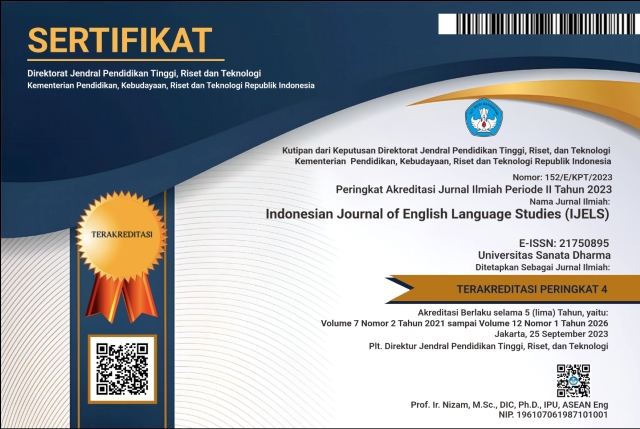A Morphological Analysis of Word Formation Process Used in Mobile Application Names
(1) Sanata Dharma University, Indonesia
(*) Corresponding Author
Abstract
A study of the word formation process, especially in mobile application names is interesting to study since there has not been sufficient research that studies this phenomenon. In this case, the researcher was interested in revealing the word formation process found in mobile application names in Google Play Store. This study was a content analysis that employed word formation process proposed by Yule (2010). Therefore, this study aimed to investigate the word formation process found in mobile application names in Google Play Store with several categories. The findings showed that the word formation process occurred in four processes, namely compounding, blending, derivation, and multiple processes. Here, the multiple processes dominate the other processes which occurred in four application names. The compounding processes occurred in two applications, followed by the blending processes with two occurrences, and the other two appeared in the derivation process. Nevertheless, the clipping, acronym, coinage, and borrowing processes were not found in this study. Hence, the results indicate that the word formation processes in mobile application names also employed capitalization stylistic to raise more appealing brands. Therefore, the researcher suggests that future researchers can fill in the gap on the word formation process in particular scopes such as in game and e-commerce application names.
Keywords
Full Text:
PDFReferences
Anandan, C. (2009). Product management (2nd ed.). Chennai: Tata McGraw-Hill Education.
Anggrisia, N. F., Rosyidah, I., & Riza, A. (2019). Word Formation Process on Best Seller Food Brand Name in Grab and Go-Jek Application. JETLe, 1(2), 28 - 37. doi:DOI: https://doi.org/10.18860/jetle.v1i2.9154
Batey, M. (2008). Brand meaning. New York: Routledge.
Creswell, J. W. (2009). Research design: Qualitative, quantitative, and mixed methods approches (3rd ed.). Thousand Oaks: SAGE Publications, Inc.
Crystal, D. (2008). A dictionary of linguistics and phonetics. Oxford: Blackwell Publishing.
Danesi, M. (2004). Messages, signs, and meanings: A basic textbook in semiotics and communication. Toronto: Canadian Scholars’ Press. Inc.
Danks, D. (2003). Separating blends: A formal investigation of the blending process in english and its relationship to associated word formation processes. Liverpool: University of Liverpool.
Dictionary.com. (2021). Retrieved from Dictionary.com, LLC: https://www.dictionary.com/
Faradisa, A., Aziz, Z. A., & Yasin, B. (2019). An analysis of word formation processes found in Instagram. Research in English and Education (READ), 4(2), 52-64.
Giyatmi, G., Arumi, S., & Setiyono, M. S. (2021). Word formation of messaging applications found in Playstore. Lire Journal (Journal of Linguistics and Literature), 5(1), 92-109. doi:https://doi.org/10.33019/lire.v3i2.106
Hacken, P. T., & Thomas, C. (2013). The semanticsof word formation and lexicalization. Edinburgh: Edinburgh University Press.
Handayani, H. (2013). The process of word formation and phrase structure of android application names. LANTERN (Journal on English Language, Culture and Literature), 2(1), 167-177.
Kortmann, B. (2005). English linguistics: Essentials. Berlin: Cornelsen.
Krippendorff, K. H. (2004). Content analysis: An introduction to its methodology (2nd ed.). Thousand Oaks: SAGE Publications, Inc.
Lieber, R. (2009). Introducing morphology. Cambridge: Cambridge University Press.
McCarthy, A. C. (2002). An introduction to English morphology. Edinburgh: Edinburgh University .
Moehkardi, R. R. (2016). Patterns and meanings of English words through word formation processes of acronyms, clipping, compound and blending found in internet-based media. Humaniora, 28(3), 324-338.
Montero-Fleta, B. (2011). Suffixes in word-formation processes in scientific English. LSP Journal, 2(2), 4-14.
Mustafa, S. Z., Kandasamy, M. D., & Yasin, M. S. (2015). An analysis of word formation process in everyday communication on Facebook. International Journal of Education and Research (IJERN), 3(6), 261 - 274.
Pamungkas, K. (2015). Word formation and product naming strategy: A study of morphology. The Role of Indigenous Languages in Constructing Identity (pp. 81-85). Semarang: Universitas Diponegoro.
Plag, I. (2003). Word-formation in English. Cambridge: Cambridge University Press.
Ratih, E., & Gusdian, R. I. (2018). Word formation processesin English new Wordsof Oxford English Dictionary. CELTIC: A Journal of Culture, English Language Teaching, Literature & Linguistics, 5(2), 24-35. https://doi.org/10.22219/celtic.v5i2.7617
Viramdani, I. R., & Himmawati, D. R. (2017). Morpho-semantic analysis in electronic product brands. Language Horizon, 5(1), 1-11.
Ward, C. (2014, April 27). My customer. Retrieved from My Customer: https://www.mycustomer.com/marketing/strategy/psychologist-reveals-capital-letters-work-better-for-brand-names
Yule, G. (2010). The study of language (4th ed.). New York: Cambridge University Press.
DOI: https://doi.org/10.24071/ijels.v8i2.3692
Refbacks
- There are currently no refbacks.

This work is licensed under a Creative Commons Attribution-ShareAlike 4.0 International License.
IJELS Journal Sinta 4 Certificate (S4 = Level 4)
We would like to inform you that Indonesian Journal of English Language Studies (IJELS) has been nationally accredited Sinta 4 by the Ministry of Education, Culture, Research and Technology of the Republic of Indonesia based on the decree No. Surat Keputusan 152/E/KPT/2023. Validity for 5 years: Vol 7 No 2, 2021 till Vol 12 No 1, 2026

This work is licensed under CC BY-SA.
Creative Commons Attribution-ShareAlike 4.0 International License
IJELS e-ISSN 2715-0895; IJELS p-ISSN 2442-790X
Indonesian Journal of English Language Studies (IJELS) is published twice a year, namely in March and September, by the English Language Studies (ELS) of the Graduate Program of Sanata Dharma University, Yogyakarta, Indonesia.


 IJELS p-ISSN:
IJELS p-ISSN: 














